Welcome to my tasty guide that delves into the world of steaks and uncovers the calorie count of a 7 oz steak. Steaks are a beloved indulgence, synonymous with flavor and satisfaction. However, it’s essential to strike a balance between taste and health when enjoying this meaty delight. In this guide, we will explore the calorie content of a 7 oz steak, shed light on different cuts and their nutritional information, and provide tips for creating a well-rounded and nutritious meal. So, grab your fork and let’s dig in!
- The calorie count of a 7 oz steak can vary depending on the type of cut and cooking method.
- A 3 oz serving of steak generally contains around 160-250 calories.
- Steak is a great source of protein and important vitamins and minerals like iron, zinc, and vitamin B12.
- Portion control and choosing healthy cooking methods are crucial for enjoying steak as part of a balanced diet.
- Pairing steak with nutritious accompaniments and exploring lower-calorie alternatives are options to consider.
Understanding Steak Cuts and Calorie Content
To understand the calories in a 7 oz steak, it’s crucial to explore the various cuts of steak and how they can affect the nutritional profile. Different cuts of steak come from different parts of the animal and contain varying amounts of fat and muscle. This results in variations in calorie content and nutritional value.
Let’s take a closer look at some common steak cuts and their calorie counts per 7 oz serving:
| Steak Cut | Calories per 7 oz Serving |
|---|---|
| Filet Mignon | 348 |
| Ribeye | 576 |
| Sirloin | 456 |
| T-Bone | 524 |
These calorie counts are approximate values and can vary depending on the cooking method and any additional seasonings or sauces used. It’s important to note that marbling, which refers to the fat content within the meat, can significantly impact the calorie content of a steak. Cuts with more marbling tend to be higher in calories.
When considering the nutritional information for a 7 oz steak, it’s essential to take into account not only the calorie content but also the protein, fat, and micronutrient composition. Steak is a good source of high-quality protein, which is essential for muscle growth and repair. It also contains important vitamins and minerals such as iron, zinc, and vitamin B12, which play significant roles in maintaining overall health.
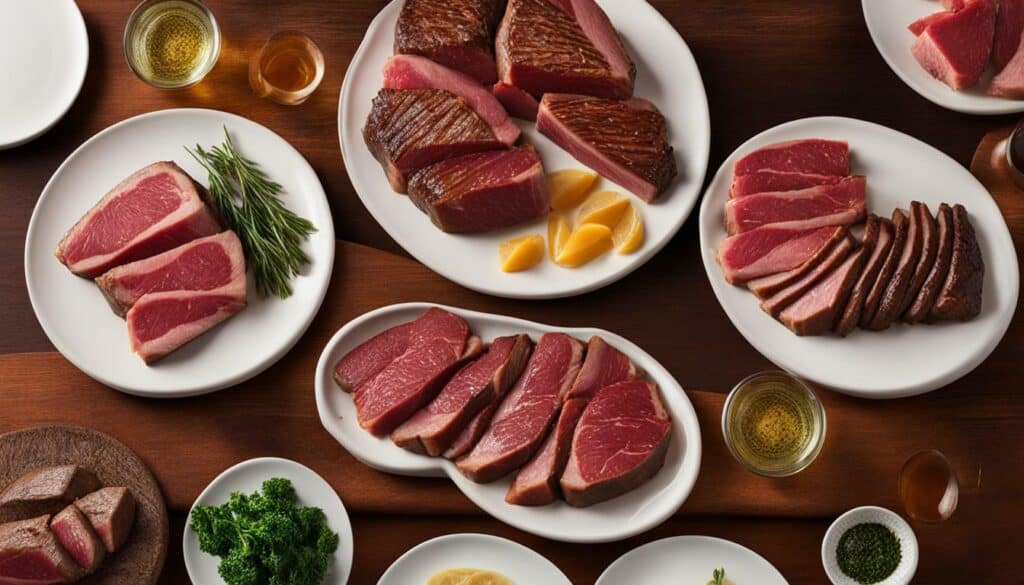
When selecting a steak, it’s important to consider your dietary goals and preferences. If you’re looking for a leaner option, cuts like filet mignon or sirloin may be more suitable. On the other hand, if you enjoy a juicier and more flavorful steak, cuts like ribeye or T-bone can be a delicious choice.
Ultimately, understanding the different cuts of steak and their calorie content allows you to make informed choices that align with your nutritional needs and personal taste preferences. Incorporating steak into a well-balanced diet can provide essential nutrients while satisfying your taste buds.
Calorie Ranges for Different Cuts of Steak
Let’s dive into the calorie ranges for different cuts of steak, keeping in mind that the following numbers represent a 7 oz serving size. When it comes to steak, the calorie content can vary depending on the cut and cooking method. It’s important to be aware of these differences to make informed choices about your meal.
Here’s a breakdown of the calorie ranges for some popular cuts of steak:
| Cut of Steak | Calories |
|---|---|
| Filet Mignon | 390-470 |
| Ribeye | 480-670 |
| Sirloin | 400-610 |
| New York Strip | 460-630 |
| T-Bone | 490-670 |
As you can see, the calorie content can range significantly depending on the choice of steak. If you’re looking for a leaner option, the filet mignon tends to have fewer calories compared to cuts like ribeye or T-bone. It’s important to note that these numbers are subject to variations based on factors such as marbling and cooking fat used, so slight deviations are possible.
Remember, enjoying steak can be part of a balanced diet. While keeping an eye on the calorie content, also consider the nutritional benefits, such as its high protein content and essential vitamins and minerals. A well-balanced meal with steak can provide you with important nutrients like iron, zinc, and vitamin B12.
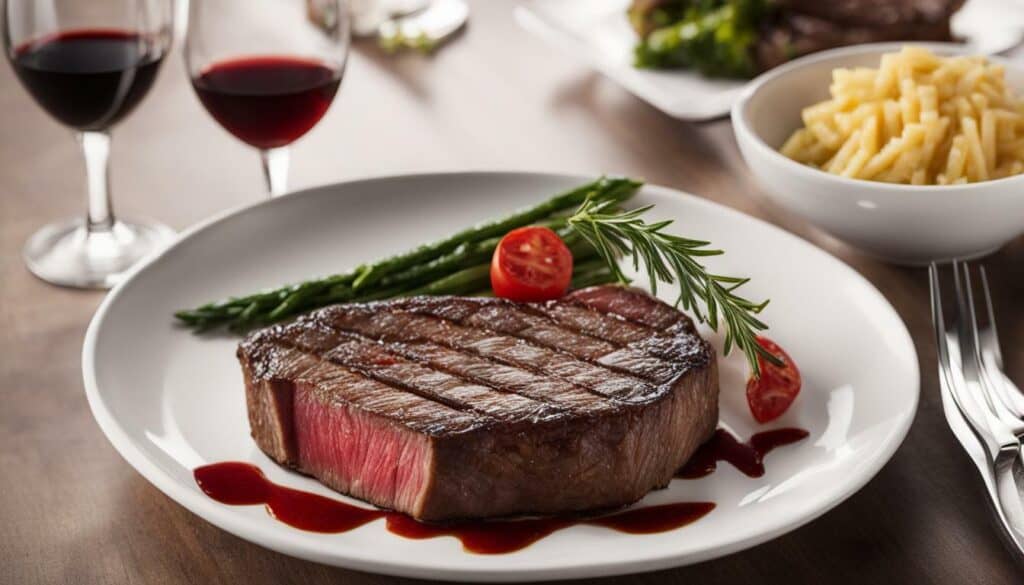
When savoring your steak, it’s crucial to practice portion control and choose healthy cooking methods. Trim excess fat before cooking and opt for grilling, broiling, or baking instead of frying. These methods help reduce excess calories while still retaining the delicious flavors of the steak.
In conclusion, understanding the calorie ranges for different cuts of steak can help you make informed choices that align with your dietary goals. By enjoying steak in moderation, paired with balanced accompaniments and cooked using healthy methods, you can savor this flavorful protein while still maintaining a nutritious and mindful approach to your meals.
Popular Steak Cuts and Their Calorie Counts
Here are some popular steak cuts and their corresponding calorie counts per ounce, helping you make informed choices for your next delicious meal. Whether you prefer a tender Filet Mignon or a flavorful Ribeye, it’s essential to be aware of the calorie content to maintain a balanced diet.
| Steak Cut | Calories per Ounce |
|---|---|
| Filet Mignon | 40 |
| Ribeye | 55 |
| Sirloin | 60 |
| New York Strip | 52 |
| T-Bone | 58 |
These calorie counts are approximate and may vary depending on factors such as the cooking method and additional seasonings or sauces. Remember to consider the portion size when calculating the total calorie intake.
“Choosing lean cuts of steak, such as Filet Mignon or Sirloin, can help reduce overall calorie consumption.”
It’s worth noting that leaner cuts tend to have fewer calories, while fattier cuts like Ribeye or T-Bone may have slightly higher calorie content. However, these cuts also offer a rich flavor and marbling that can be enjoyed in moderation as part of a balanced diet.
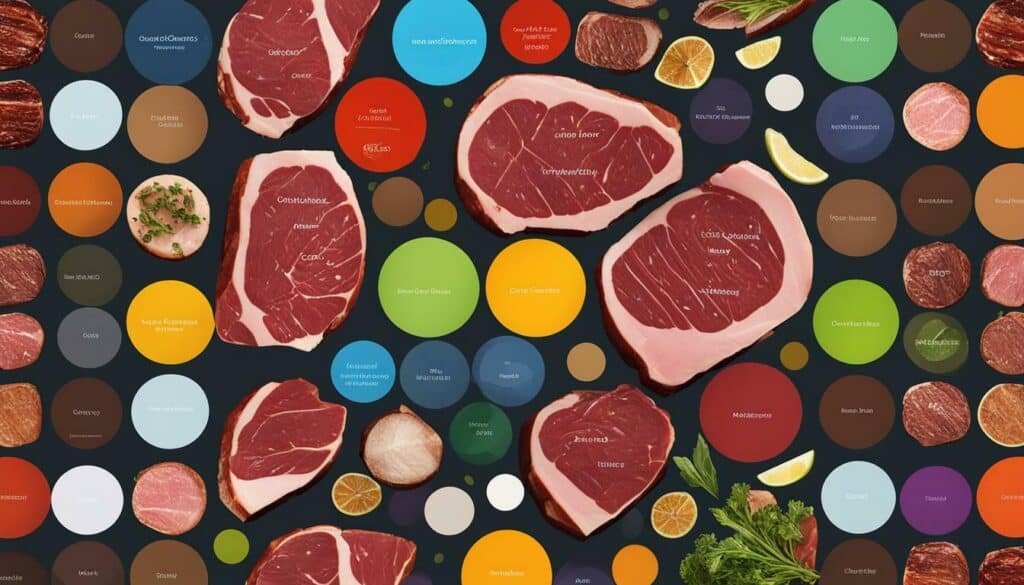
By being aware of the calorie counts and making mindful choices, you can still indulge in a delicious steak while maintaining your health goals. Consider pairing your steak with nutritious side dishes like roasted vegetables or a fresh salad to complete your meal. Remember, it’s all about finding the right balance between taste and nutrition.
The Nutritional Benefits of Steak
Not only is steak a mouthwatering delight, but it also offers an array of nutritional benefits, making it a valued addition to a balanced diet. Steak is a great source of protein, which is essential for building and repairing tissues in the body. It also contains important vitamins and minerals that support overall health.
Protein: A 7 oz steak provides a significant amount of protein, which is necessary for the growth and maintenance of muscles, organs, and tissues. Protein also helps to keep you feeling full and satisfied, making it an excellent choice for those looking to manage their weight.
Vitamins and Minerals: Steak is rich in essential vitamins and minerals, including iron, zinc, and vitamin B12. Iron is important for transporting oxygen throughout the body and preventing anemia. Zinc supports immune function and wound healing, while vitamin B12 helps maintain healthy nerve cells and red blood cells.
Fat Content: While steak does contain fat, choosing lean cuts and trimming excess fat can help reduce the overall fat content. Opting for lean cuts like sirloin or tenderloin can provide all the nutritional benefits of steak with less saturated fat.
| Nutrient | Amount per 7 oz Steak |
|---|---|
| Protein | Approximately 50 grams |
| Iron | Approximately 3-4 milligrams |
| Zinc | Approximately 6-8 milligrams |
| Vitamin B12 | Approximately 2-3 micrograms |
When incorporating steak into your diet, remember to practice portion control and choose healthy cooking methods to maximize its nutritional benefits. By enjoying steak alongside a variety of vegetables and whole grains, you can create a well-rounded and nutritious meal.

Steak is not only a delicious indulgence but also a nutritional powerhouse. When enjoyed as part of a balanced diet, it can provide essential nutrients that contribute to overall health and well-being. So go ahead and savor that perfectly cooked steak, knowing that you’re nourishing your body with every delicious bite.
Portion Control and Health Considerations
While enjoying steak, it’s essential to be mindful of portion sizes to align with your health goals and maintain a balanced lifestyle. Although steak can be a nutritious choice, it’s important to remember that its calorie count can vary depending on the cut and cooking method. By being conscious of portion sizes, you can still savor the deliciousness of steak while ensuring you’re not consuming excessive calories.
So, how much steak should you be eating? A general guideline is to aim for a 3 oz serving, which contains around 160-250 calories. This portion size provides a healthy balance of protein and other nutrients without going overboard on the calorie count. By scaling down your steak serving size, you can still enjoy the flavors and benefits of this meat while managing your caloric intake.
One way to keep track of your portion is to use the palm of your hand as a visual guide. A 3 oz serving of steak is roughly equivalent to the size and thickness of your palm. This simple method can help you gauge an appropriate portion, especially when dining out or grilling at home. Remember, moderation is the key to maintaining a healthy relationship with food.
| Steak Cut | Calories per 3 oz serving |
|---|---|
| Ribeye | 235 |
| Sirloin | 205 |
| Tenderloin | 175 |
When it comes to preparing your steak, opt for healthy cooking methods that don’t add excessive calories. Grilling, broiling, or baking are great options that don’t require the use of additional fats or oils. By avoiding deep frying or excessive marinating, you can retain the nutritional benefits of the meat without unnecessary calorie intake.

Remember, steak can be a part of a balanced diet when enjoyed in moderation and prepared using healthier methods. By being mindful of portion sizes and choosing the right cooking techniques, you can indulge in the deliciousness of steak while maintaining a nutritious lifestyle.
Healthy Cooking Methods for Steaks
Discover some fantastic cooking methods for steaks that not only preserve their nutritional value but also enhance their flavors. Whether you prefer a juicy ribeye or a lean sirloin, these techniques will help you create a delicious and healthy meal.
First, let’s talk about grilling. Using a grill allows the fat to drip away from the steak, resulting in a leaner end product. To avoid charring or burning, preheat the grill to medium-high heat and lightly oil the grates. Place the steak on the grill and cook for about 4-5 minutes per side for medium-rare, or adjust the cooking time to your desired level of doneness. Remember to let the steak rest for a few minutes before slicing to seal in the juices.
If grilling isn’t an option, try broiling your steak. Preheat the broiler and position the rack about 6 inches from the heat source. Season the steak with your favorite herbs and spices, place it on a broiler pan, and place it under the broiler. Cook for about 4-6 minutes per side, again adjusting the time to your preference. Broiling yields a deliciously caramelized crust while keeping the interior tender and juicy.
Another healthy cooking method is pan-searing. Heat a skillet over medium-high heat and add a small amount of oil. Carefully place the steak in the skillet and cook for 3-4 minutes per side for medium-rare. For added flavor, you can baste the steak with melted butter and crushed garlic during cooking. Pan-searing creates a beautiful crust and locks in the natural juices.

Remember, proper seasoning is key to enhancing the flavor of your steak. Use a combination of salt, pepper, and other spices to add depth and richness. And don’t forget to experiment with marinades or dry rubs for an extra burst of flavor. With these healthy cooking methods, you can enjoy a tasty steak while maintaining a balanced diet.
Choosing Balanced Accompaniments for Steak
Complement your steak with nutritious and balanced accompaniments to create a satisfying and wholesome dining experience. While steak itself provides important nutrients, combining it with the right sides can enhance both the flavor and nutritional value of your meal. Here are some ideas to consider:
1. Colorful Vegetable Medley
Incorporating a vibrant mix of vegetables not only adds visual appeal to your plate but also boosts the nutrient content. Consider steamed or roasted veggies like broccoli, bell peppers, carrots, and asparagus. These colorful options provide essential vitamins, minerals, and fiber, helping to create a well-rounded meal.
2. Whole Grains
Choose whole grains like quinoa, brown rice, or whole wheat couscous as a nutritious side to your steak. These grains add texture and flavor while providing dietary fiber, complex carbohydrates, and valuable nutrients. They can also help you feel fuller for longer, promoting a sense of satiety.
3. Leafy Green Salad
Pair your steak with a refreshing salad made with dark leafy greens like spinach or arugula. Add a variety of colorful veggies, such as cherry tomatoes, cucumbers, and red onions. Top it off with a light vinaigrette or a squeeze of lemon for a burst of freshness. Salads are a great way to incorporate additional vitamins and minerals while keeping the calorie count low.
Remember to be mindful of portion sizes. Aim for a balanced plate, with about half of it filled with vegetables, a quarter dedicated to protein (steak), and the remaining quarter for whole grains or other sides. This will help you create a well-rounded and satisfying meal that supports your nutritional goals.
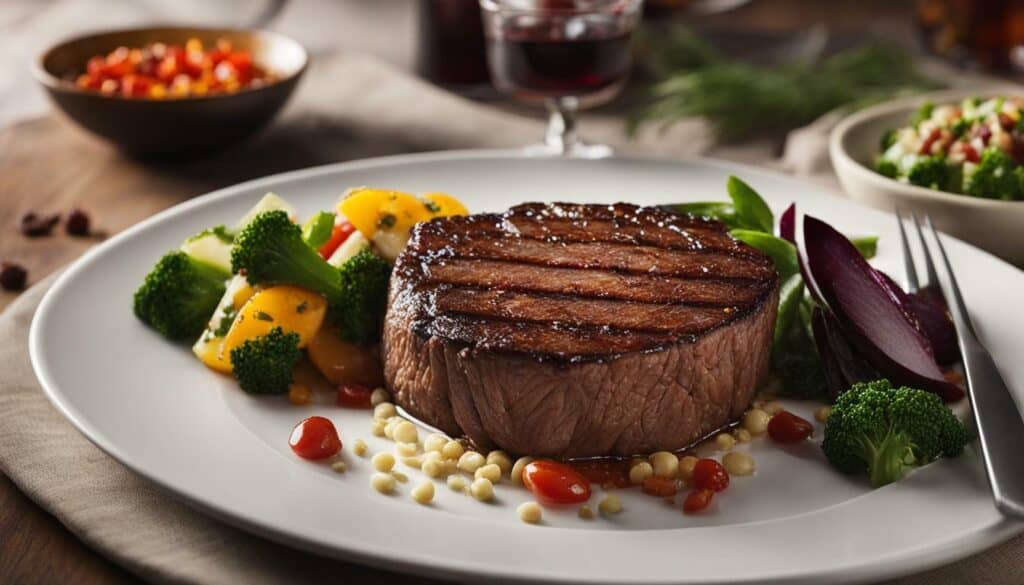
| Side Dish | Calories (per serving) | Key Nutrients |
|---|---|---|
| Steamed Broccoli | 55 | Vitamin C, Vitamin K, Fiber |
| Quinoa Pilaf | 220 | Protein, Fiber, Iron |
| Spinach Salad | 75 | Vitamin A, Vitamin K, Folate |
| Roasted Sweet Potatoes | 180 | Vitamin A, Fiber, Potassium |
“Creating a well-balanced meal with steak involves more than just the meat itself. Choosing nutritious accompaniments can elevate your dining experience and provide additional health benefits.” – Nutritionist Sarah Johnson
Dining Out: Navigating Steakhouse Menus
Here are some tips to help you make healthier decisions when dining out at a steakhouse and savoring a delicious steak.
1. Pay attention to portion sizes: Steak portions can vary greatly at different restaurants. Opt for a reasonable portion size, around 3-4 ounces, to control your calorie intake while still enjoying the flavors of a perfectly cooked steak.
2. Choose leaner cuts: Some steak cuts, such as sirloin or filet mignon, tend to be leaner and lower in fat compared to ribeye or T-bone steaks. These cuts often have fewer calories and less saturated fat, making them a healthier choice.
3. Go easy on the sauces and toppings: While sauces, butter, and other delicious accompaniments can enhance the flavor of your steak, they can also add extra calories and unhealthy fats. Opt for healthier alternatives like a squeeze of fresh lemon juice or a sprinkle of herbs to enhance the taste without piling on extra calories.
4. Ask for your steak to be prepared using healthier cooking methods: Grilled or broiled steaks are generally healthier choices compared to fried or pan-seared options. These cooking methods help to reduce the amount of added fat and calories. Be sure to request that your steak is cooked with minimal oil or butter.

Remember, enjoying a steak at a steakhouse doesn’t mean you have to sacrifice your health goals. By making mindful choices and being aware of portion sizes and cooking methods, you can still savor a delicious steak while staying on track with your nutrition. Bon appétit!
Steak Alternatives for Calorie-Conscious Individuals
If you’re on a calorie-conscious journey, these steak alternatives can provide a delicious and nutritious alternative to satisfy your cravings. While steak is undeniably tasty, it can sometimes be high in calories, especially when consumed in large portions or prepared with rich sauces or excessive oils. Fortunately, there are plenty of healthier options to consider that still offer great flavor and can be incorporated into various dishes.
One popular alternative to steak is grilled chicken breast. It is lean, low in calories, and high in protein, making it an excellent choice for those watching their calorie intake. You can season it with herbs and spices or marinate it in a flavorful sauce to add a burst of taste. Grilled salmon is another fantastic option, packed with heart-healthy omega-3 fatty acids and essential nutrients. Its rich, buttery flavor pairs well with a variety of side dishes.
If you prefer a meatless option, portobello mushrooms are worth a try. These large, meaty fungi are a great substitute for steak, especially when grilled or roasted. They have a satisfying texture and absorb flavors beautifully, making them an ideal choice for vegetarian or vegan meals. Other plant-based alternatives include tofu and tempeh, which can be marinated and grilled to mimic the taste and texture of steak.
| Steak Alternative | Calories per 3 oz serving | Protein per 3 oz serving |
|---|---|---|
| Grilled Chicken Breast | 120-150 | 25-30 grams |
| Grilled Salmon | 150-200 | 20-25 grams |
| Portobello Mushrooms | 20-30 | 1-2 grams |
| Tofu | 70-100 | 7-9 grams |
| Tempeh | 90-120 | 10-13 grams |
Remember, when incorporating these steak alternatives into your meals, it’s essential to consider the cooking method and portion sizes. Grilling, baking, or broiling are all healthier options compared to frying or sautéing in oil. Additionally, pairing these alternatives with nutrient-dense side dishes like roasted vegetables, whole grains, or leafy greens can help create a well-balanced and satisfying meal. So, don’t be afraid to explore these alternatives and discover new flavors while staying on track with your calorie-conscious goals.
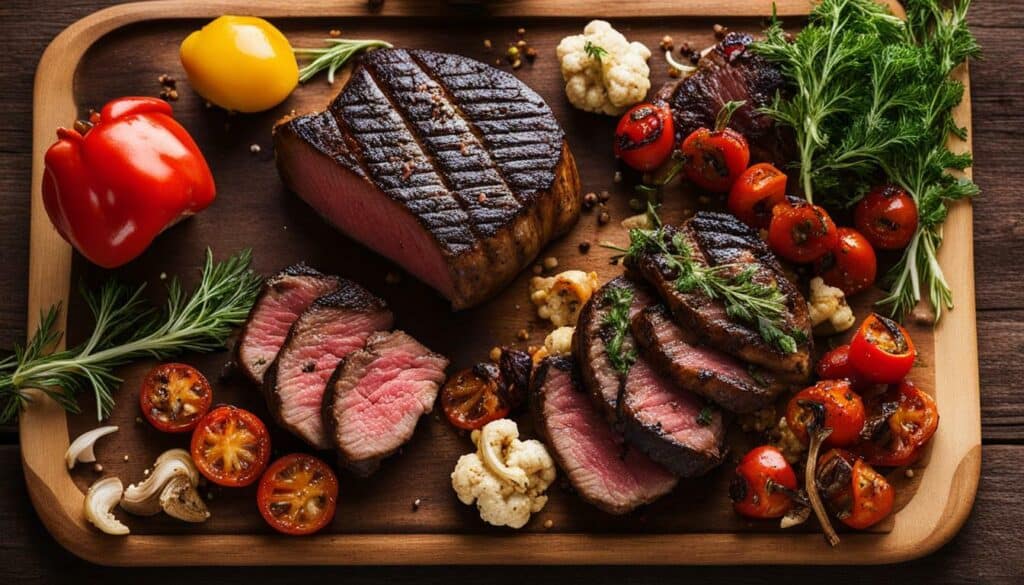
Conclusion
Exploring the calories in a 7 oz steak has shed light on the nutritional aspects of this delectable protein choice, reminding us that balance and mindfulness are the keys to savoring it while maintaining a healthy lifestyle.
When it comes to steak, understanding the different cuts and their calorie content is essential. The calorie count can vary depending on the cut and cooking method, but generally, a 3 oz serving of steak contains around 160-250 calories. By being aware of the calorie ranges for different cuts of steak, we can make informed choices that align with our dietary goals.
Aside from calories, steak offers numerous nutritional benefits. It is a great source of protein, which is crucial for muscle repair and growth. Additionally, steak provides essential vitamins and minerals like iron, zinc, and vitamin B12. These nutrients play vital roles in supporting our overall health and well-being.
To ensure a balanced meal, portion control is important. Keeping serving sizes in check allows us to enjoy the flavors of steak while managing our calorie intake. It is also worth considering healthy cooking methods such as grilling, broiling, or roasting, which help retain the nutritional value of the meat.
Lastly, pairing steak with nutritious accompaniments is key. Opting for fresh vegetables, whole grains, and lighter sauces can enhance the nutritional value of the meal. When dining out at steakhouse restaurants, being mindful of our choices and seeking healthier options can help us stay on track with our health goals.
In conclusion, exploring the calories in a 7 oz steak has provided valuable insights into the nutritional aspect of this beloved protein. By being mindful of portion sizes, selecting healthy cooking methods, and choosing balanced accompaniments, we can relish the taste of steak while staying on a path of wellness. So let’s savor our steaks with gratitude, knowing that we can enjoy them in a way that supports our overall health and wellness journey.
FAQ
Q: How many calories are in a 7 oz steak?
A: The calorie count in a 7 oz steak can vary depending on the cut and cooking method. Generally, a 3 oz serving of steak contains around 160-250 calories. So, a 7 oz steak would roughly have double that amount, between 320-500 calories.
Q: What are the different cuts of steak and their calorie content?
A: The calorie content of steak can vary depending on the cut. Some popular cuts and their approximate calorie counts per ounce include: sirloin (60-80 calories), rib-eye (70-80 calories), filet mignon (50-60 calories), and strip steak (70-80 calories). These numbers are based on a 7 oz serving size.
Q: What are the nutritional benefits of steak?
A: Steak is a great source of protein and essential vitamins and minerals. It contains important nutrients like iron, zinc, and vitamin B12. These nutrients play a crucial role in supporting energy production, immune function, and overall health.
Q: How can I make healthier choices when consuming steak?
A: Portion control is key when enjoying steak. Be mindful of your serving size and pair it with healthy accompaniments like vegetables or a side salad. Additionally, opt for healthier cooking methods like grilling or broiling instead of frying to reduce excess calories.
Q: Are there lower-calorie alternatives to steak?
A: If you’re looking for lower-calorie options, you can consider alternatives like lean cuts of poultry, fish, or plant-based proteins like tofu or tempeh. These options can still provide a good source of protein while being lower in calories compared to steak.
How Can the French Toast Size Chart Help Me Find the Perfect Fit?
Finding the right size can be a challenge, but fear not! The perfect fit french toast size chart is here to help. With a quick glance, you can determine which size suits you best. No more guessing or uncertainty. This chart is your guide to finding the perfect fit for your French toast cravings.

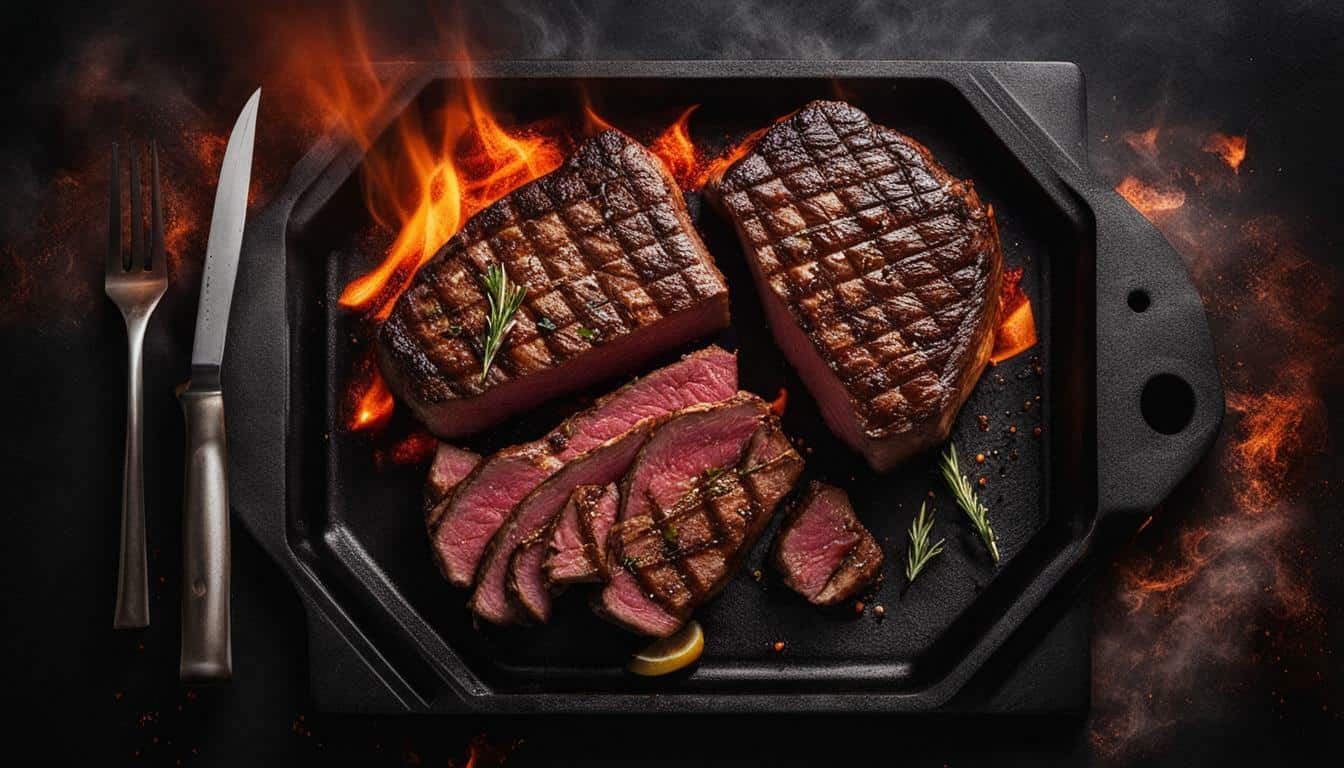



Leave a Reply